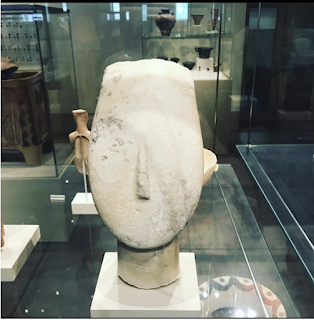 |
| In the Aegean Bronze Age section at the Metropolitan Museum of Art in New York City, you can find Cycladic art, famous for its abstract and stylized human figures, predominantly female, dating from around 2800 to 2300 BCE. |
I'm at the Metropolitan Museum of Art, looking at the museum's collection of Cycladic art. Located in the Greek wing of the @metmuseum's Cycladic art collection, this ancient sculptural representation of a human face is perhaps one of my favorite art objects (ever!). Dating from the 3rd millennium BCE to the 1st millennium B.C.E., these sculptures represent a culture that developed around 3300 B.C.E. in the Aegean Sea.
 |
| An aerial, stylized view of the Aegean Sea, dotted with the Cyclades islands, nestled between Greece, Anatolia, and Crete. |
🗣️ Known for their abstract, stylized forms, these ancient works could easily be placed in the Museum of Modern Art @MoMA) and fit right in. We don't know exactly what the objects were used for, but some scholars believe that they may have been used as votive offerings, grave goods, or even status symbols.

No comments:
Post a Comment
Be courteous. Speak your mind. Don’t be rude. Share.